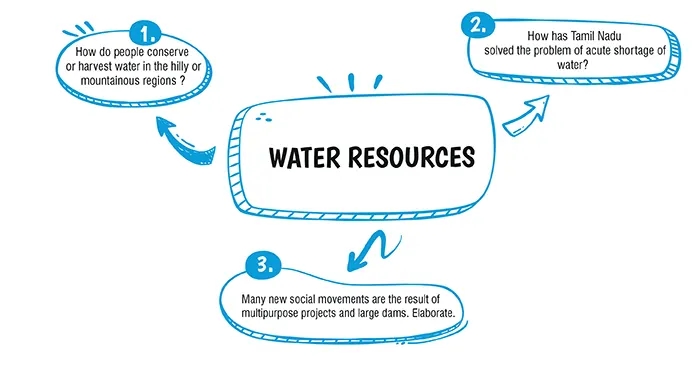Home / Boards / CBSE / Important Questions / Class 10 / Social Science / Water Resources
Table of Contents

Ans. (d)
Explanation:
The factor responsible is Over-utilization.
Human activities such as over usage and water pollution cause water scarcity.
Ans. (b)
Explanation:
Mawsynram receives the highest rainfall in India. It is reportedly the wettest place on Earth, with an average annual rainfall of 11,872 millimetres (467.4 in)
Explanation:
By building diversion channels like the ‘guts’ or ‘kuls’.
Explanation:
Tamil Nadu has been able to deal with the problem of acute shortage of water by adopting rooftop water harvesting techniques. This practice was made mandatory under the law for all houses across the state.
Explanation:
The new social movements are the result of multipurpose projects and large dams as follows:
1. Narmada Bachao Andolan and Tehri Dam Andolan are the results of these multipurpose projects.
2. Resistance to these projects has primarily been due to the large-scale displacement of local communities. Local people often had to give up their land, livelihood and their meagre access and control over resources for the greater good of the nation.
3. Irrigation has changed the cropping pattern of many regions with farmers shifting to intensive and commercial crops. This has great ecological consequences like salinization of the soil.
4. It has transformed the social landscape i.e., increasing the social gap between the rich landowners and the landless poor.
5. The dams also created the conflict between people wanting different uses and benefits from the same water resources. In Gujarat, the Sabarmati basin farmers were agitated and rioted over the higher priority given to water supply in urban areas, particularly during the droughts. Interstate water disputes have become popular related to sharing of the costs and benefits of the multi-purpose project.
Download Mind Map of this chapter
Download NowWant to Practice Mock Tests of this chapter
Practice NowDownload Important Questions of this chapter
Download Now| Chapter No. | Chapter Name |
|---|---|
| History | |
| Chapter 1 | The Rise of Nationalism in Europe |
| Chapter 2 | Nationalism in India |
| Chapter 3 | The Making of a Global World |
| Chapter 4 | The Age of Industrialization |
| Chapter 5 | Print Culture and the Modern World |
| Geography | |
| Chapter 6 | Resources and Development |
| Chapter 7 | Forest and Wildlife Resources |
| Chapter 8 | Water Resources |
| Chapter 9 | Agriculture |
| Chapter 10 | Minerals and Energy Resources |
| Chapter 11 | Manufacturing Industries |
| Political Science | |
| Chapter 12 | Power – sharing |
| Chapter 13 | Federalism |
| Chapter 14 | Gender, Religion and Caste |
| Chapter 15 | Political Parties |
| Chapter 16 | Outcomes of Democracy |
| Economics | |
| Chapter 17 | Development |
| Chapter 18 | Sectors of the Indian Economy |
| Chapter 19 | Money and Credit |
| Chapter 20 | Globalization and The Indian Economy |
| Chapter Wise Important Questions for CBSE Board Class 10 Geography |
|---|
| Resources and Development |
| Forest and Wildlife Resources |
| Water Resources |
| Agriculture |
| Minerals and Energy Resources |
| Manufacturing Industries |
CBSE Important Questions Class 10
ICSE Important Questions Class 10
CBSE Important Questions Class 10
ICSE Important Questions Class 10